Schoenus crassiculmis
Schoenus crassiculmis is a species of sedge endemic to the mountains of the Western Cape Province of South Africa.[1] Few collections of this species have also been made from western areas of the Eastern Cape Province.[1]
| Schoenus crassiculmis | |
|---|---|
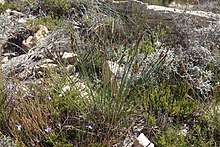 | |
| Succulent veldrush | |
| Scientific classification | |
| Kingdom: | Plantae |
| Clade: | Tracheophytes |
| Clade: | Angiosperms |
| Clade: | Monocots |
| Clade: | Commelinids |
| Order: | Poales |
| Family: | Cyperaceae |
| Genus: | Schoenus |
| Species: | S. crassiculmis |
| Binomial name | |
| Schoenus crassiculmis T.L.Elliott & Muasya | |
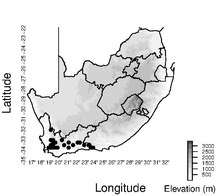 | |
| Documented collection localities | |
Description
Schoenus crassiculmis is a sedge that appears semi-succulent in the field. [1] Other important characters are its basal leaves that are reduced in length and the relatively short lower glumes of its spikelets.[1]
In the field, Schoenus auritus also appears semi-succulent, but that species generally has longer leaves (usually half the length of the flowering stems). Schoenus crassiculmis, in contrast, has basal leaves that never exceed half the length of the flowering stems.[1] The lower spikelet glumes of S. crassiculmis are relatively short compared to those of S. auritus, whose glumes mostly exceed half the spikelet length.[1] Another important difference between the two species are that S. auritus has membranaceous leaf sheaths, whereas S. crassiculmis does not.[1] Finally, S. auritus has proximal and subproximal primary inflorescence bracts that are more expanded at their bases than in S. crassiculmis.[1]
Similar to other sedges, plants in this group are very difficult to identify. It appears that part of this problem is caused by the tendency of the southern African Schoenus to form hybrids with each other.[2] From preliminary evidence, S. crassiculmis appears to be of hybrid origin.[1]
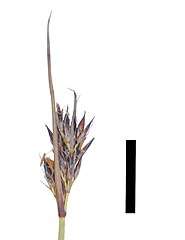 Flowering head (black scale bar represents 10 mm)
Flowering head (black scale bar represents 10 mm)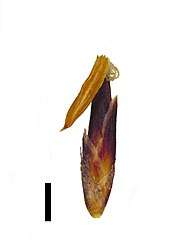 Spikelet (black scale bar represents 1 mm)
Spikelet (black scale bar represents 1 mm)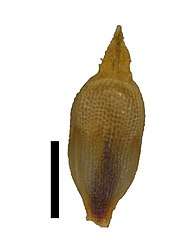 Nutlet (black scale bar represents 1 mm)
Nutlet (black scale bar represents 1 mm)
Taxonomy
Schoenus crassiculmis is a species in family Cyperaceae, tribe Schoeneae.[1] Other notable genera in tribe Schoeneae include Lepidosperma, Oreobolus, Costularia, Tetraria and Gahnia.[1][3][4] The most closely-related species to S. crassiculmis are other southern African Schoenus species, specifically, species in the S. cuspidatus and allies group.[1]
Southern African Schoenus were once classified as Tetraria; however, based on molecular and morphological differences, we now know that the two groups are evolutionary distinct.[5] To ensure that this group of sedges is monophyletic (i.e. the genus only has closely-related species), the southern African Tetraria were transferred into Schoenus.[5] In the field, the southern African Schoenus can be distinguished from Tetraria species by their lack of stem leaves and the absence of reticulate sheaths at the bases of the flowering stems.[5]
Distribution and habitat
Schoenus crassiculmis has a distribution that ranges from the Worcester area of the Western Cape Province in the west to the Willowmore area of the Eastern Cape Province in the east.[1] This species has predominately been collected from sandstone-derived mountain slopes, but a few collections have also been made from sites with shale parent material.[1]
Images
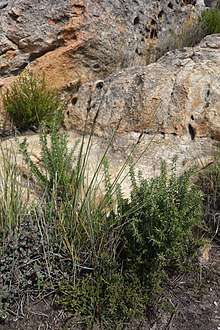 Growth form of S. crassiculmis
Growth form of S. crassiculmis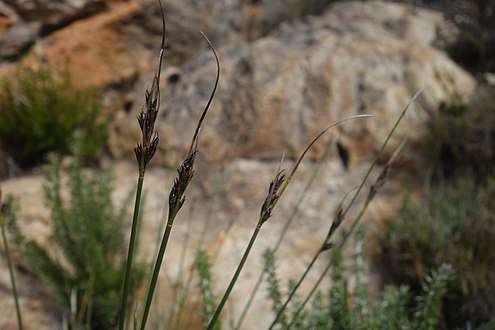 Flowering heads
Flowering heads
References
- Elliott, T.L.; Barrett, R.L.; Muasya, A.M. (2019). "A taxonomic revision of Schoenus cuspidatus and allies (Cyperaceae, tribe Schoeneae)—Part 1". South African Journal of Botany. 121: 519–535. doi:10.1016/j.sajb.2018.11.021.
- Levyns, M. (1947). "Tetraria and related genera, with special reference to the flora of the Cape Peninsula". Journal of South African Botany. 13: 73–93.
- Viljoen, J.-A.; Muasya, A.M.; Barrett, R.L.; Bruhl, J.J.; Gibbs, A.K.; Slingsby, J.A.; Wilson, K. L.; Verboom, G.A. (2013). "Radiation and repeated transoceanic dispersal of Schoeneae (Cyperaceae) through the southern hemisphere". American Journal of Botany. 100 (12): 2494–2508. doi:10.3732/ajb.1300105.
- Larridon, I.; Bauters, K.; Semmouri, I.; Viljoen, J.-A.; Prychid, C.J.; Muasya, A.M.; Bruhl, J.J.; Wilson, K.L.; Senterre, B.; Goetghebeur, P. (2018). "Molecular phylogenetics of the genus Costularia (Schoeneae, Cyperaceae) reveals multiple distinct evolutionary lineages". Molecular Phylogenetics and Evolution. 126: 196–209. doi:10.1016/j.ympev.2018.04.016.
- Elliott, T.L.; Muasya, A.M. (2017). "Taxonomic realignment in the southern African Tetraria (Cyperaceae, tribe Schoeneae; Schoenus clade)". South African Journal of Botany. 112: 354–360. doi:10.1016/j.sajb.2017.06.011.